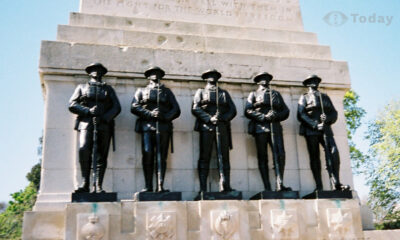
BBC
Simon Reeve heads to Patagonia wilderness
Best on the Box choice for Sunday, January 28th…
In the second episode of the four-part series, Simon Reeve travels through the wilderness of Patagonia, at the foot of the South American continent.
Simon Reeve:
“I think everyone’s got their own image and definition, or idea of what wilderness is. I would define a wilderness as a place where the impact of humanity is low, and where nature still makes the rules. The entire planet has felt the effects of humans and industrialisation, but the human impact is low in the areas we visit. Nowhere is completely untouched by humanity. There are plastic particles at the bottom of the ocean and the top of Everest, but we were looking for areas where nature was still largely in charge.”
A beautiful and rugged land of mountains, ice and endless wild grasslands, Patagonia is whipped by wind, rain, and snow. Simon’s journey takes him up to the huge South Patagonian ice field, through the foothills of the Andes towards the great Grey Glacier of eastern Chile. The South Patagonian Ice Field is a vast but little-known body of frozen fresh water that sits high in the Andes – its 53 glaciers feeding the rivers and plains of Patagonia.
To reach it, Simon must embark on a grueling mountain trek, braving the wind and storms of this brutal wilderness. It’s a long way from any help and the difficulties hit home when the team loses a key member – the camera operator – to an injury on the way up. But after three days of clambering and climbing, Simon reaches this extraordinary landscape – 500 square miles of ice, in places a mile thick.
The ice field is crucial for the way it regulates the climate and ecosystems of the whole continent, and Simon learns how much ice is being lost here to global climate change, just as in Greenland and at the poles. Continuing his journey, he follows the Andes mountains south, in search of Patagonia’s legendary gauchos.
In Taibo and Jauny, Simon encounters two extraordinary characters, who live an isolated life in the mountains, tending their livestock and braving the storms in a simple hut for months on end. They too have witnessed the changes in the climate – less rain, droughts, wildfires – and worry if their way of life can continue. Heading across the border from Argentina into Chile, Simon meets up with another clourful Patagonian character. As a young man, Vicente Montero left the big city in search of the wilderness and for ten years he has studied and helped conserve the wildlife of the region.
During an unforgettable encounter, Vicente introduces Simon to the King of Patagonia – the puma or mountain lion. Here is a conservation success story, as Chile’s pumas are thriving under government protection. Finally, Simon travels with Vicente back up to the ice – to the otherworldly and awe-inspiring Grey Glacier.
Simon Reeve:
“I’ve been on dozens of incredible journeys for all my previous series and I’ve seen the huge impact humans have had. But despite it all, there’s still a gorgeous Earth out there, a beautiful planet for us to live on and I think I needed a reminder of that, and a lot of people need that reminder as well. For the first time in human history more than half of all people live in urban areas – and in countries like the UK that goes up to more than 80%. We need to remember there’s not just a little patch of Wilderness out there in our big world, there are still huge wild areas of the planet full of mystery and beauty. We all need a bit of a reminder that it’s still out there, that it’s glorious and vital, and that it’s worth caring about and protecting.”

Wilderness with Simon Reeve
Series Facts
• While making Wilderness with Simon Reeve, Simon had a collision with a whale shark, was snared by jungle vines as he chased after bonobos in the Congo, was attacked by sweat bees, and slept in a tiny tent among lions in the desert.
•Simon went on a series of adventures and expeditions, sleeping in the jungle, on a boat crossing the sea off Indonesia, up at altitude in the mountains of Patagonia, and with the San people in the desert of southern Africa.
•Simon met a Master Tracker in the Kalahari and a former elephant poacher in the Congo who now protects one of the most important areas of Wilderness on the planet. He ate testicles with a Gaucho cowboy who is obsessed with mashed potato, and searched for mountain lions on foot in Patagonia.
•Wilderness with Simon Reeve features lions, elephants, honey badgers, whale sharks, bonobos, aardwolves, sharks, pumas, dolphins, horses, black mangabeys, and, burrowed into cameraman Jonathan Young’s foot, a lone jigger flea.
•To film the series, the team used specialist kit including cameras and lenses often used on movies, alongside robust high-street kit such as a brace of Go-Pro cameras that were strapped to poles, boats, cars, and were also used by the Baka people in the Congo to film their hunt for wild honey 25m up a tree.
•Simon’s kit included crampons, ice axe, pepper spray to ward off lions, ultralight trekking equipment, class B2 mountaineering boots, and a wild camping tent that weighs less than a bag of sugar.
•The most challenging part of the journeys was the exhausting expedition to the South Patagonia Ice field (SPIF), a huge area of frozen water high up in the Andes mountains between Chile and Argentina. The SPIF is the third largest glacial mass on the planet after Antarctica and Greenland, but little known, and in a rarely visited area of the Andes. Getting there took months of preparation, and then days of trekking up into the mountains. The team were accompanied by specialist climbers and a young team of mountain rescue specialists with the nimble abilities of a herd of goats.
•According to Simon, the worst moment filming the series was when Eric, one of the directors, fell ill with a fever on a boat in the Coral Triangle, hundreds of miles from land and the nearest clinic. Eric’s temperature was still rising, but he was treated and after he rested overnight the team made complicated plans to get to a remote island, hack through jungle, and then medivac him to hospital. Fortunately, by the morning his fever had broken and he slowly recovered.
•The trickiest moments making the series were generally not when things went wrong, such as Simon and the team falling into a peat bog in the Congo jungle that sucked them in up to their waists, because those moments were filmable. Instead, according to Simon, the trickiest moments were when they had travelled long distances to reach a point and initially, it appeared they wouldn’t be able to film anything, such as when they trekked for days through the rainforest searching for bonobos.
•While filming the series Simon learnt how to make poison arrows, gather wild honey, how some of our primate cousins are fantastic gardeners, that people poach wildlife in some areas so they can go to school, and the value of Resharking our seas. He gathered snails to hand feed baby zebra sharks, and discovered you can use a chilli bomb to scare away huge hungry elephants.
Wilderness with Simon Reeve, ‘Episode Two: Patagonia’ tonight at 9 pm on BBC Two and BBC iPlayer










